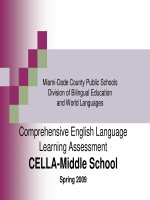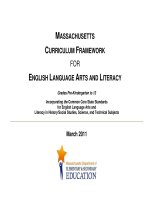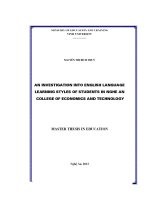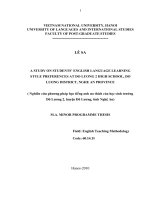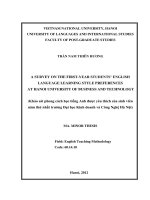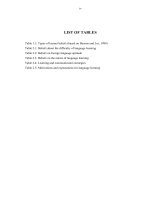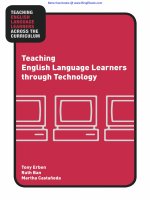English language learning and technology
Bạn đang xem bản rút gọn của tài liệu. Xem và tải ngay bản đầy đủ của tài liệu tại đây (1.37 MB, 230 trang )
English Language Learning and Technology
Language Learning and Language Teaching
The LL< monograph series publishes monographs as well as edited volumes
on applied and methodological issues in the field of language pedagogy. The
focus of the series is on subjects such as classroom discourse and interaction;
language diversity in educational settings; bilingual education; language testing
and language assessment; teaching methods and teaching performance; learning
trajectories in second language acquisition; and written language learning in
educational settings.
Series editors
Birgit Harley
Ontario Institute for Studies in Education, University of Toronto
Jan H. Hulstijn
Department of Second Language Acquisition, University of Amsterdam
Volume 7
English Language Learning and Technology: Lectures on applied linguistics
in the age of information and communication technology
by Carol A. Chapelle
English Language Learning and
Technology
Lectures on applied linguistics in the age of
information and communication technology
Carol A. Chapelle
Iowa State University
John Benjamins Publishing Company
Amsterdam/Philadelphia
8
TM
The paper used in this publication meets the minimum requirements
of American National Standard for Information Sciences – Permanence
of Paper for Printed Library Materials, ansi z39.48-1984.
Library of Congress Cataloging-in-Publication Data
Chapelle, Carol
English language learning and technology : lectures on applied linguistics
in the age of information and communication technology / Carol A.
Chapelle.
p. cm. (Language Learning and Language Teaching, issn 1569–9471
; v. 7)
Includes bibliographical references and index.
1. English language--Study and teaching--Foreign speakers. 2. English
language--Study and teaching--Technology innovations. 3. English
teachers--Training of. 4. Educational technology. 5. Information
technology. I. Title. II. Series.
PE1128.A2C444 2003
428’.0071-dc21
isbn 90 272 1703 3 (Eur.) / 1 58811 447 3 (US) (Hb; alk. paper)
isbn 90 272 1704 1 (Eur.) / 1 58811 448 1 (US) (Pb; alk. paper)
2003055680
© 2003 – John Benjamins B.V.
No part of this book may be reproduced in any form, by print, photoprint, microfilm, or
any other means, without written permission from the publisher.
John Benjamins Publishing Co. · P.O. Box 36224 · 1020 me Amsterdam · The Netherlands
John Benjamins North America · P.O. Box 27519 · Philadelphia pa 19118-0519 · usa
For my parents
Table of contents
Preface
xi
Chapter 1
The changing world of English language teaching
Visions of the invisible 2
The technologist’s vision 2
The social pragmatist’s vision 5
The critical analyst’s perspective 6
Visioning the future of ELT 9
English language learners 10
Motivation for English use with peers 11
Technology-shaped registers of English use 13
Communicative language ability for the 21st century 16
English language teachers 19
The English language 20
The study of language 20
Tasks for language learning 22
New forms of assessments 28
Research on learning 29
Teacher education and applied linguistics 30
Applied linguistics 30
Technology 31
Research methods 32
Critical analysis 32
Conclusion 33
1
Table of contents
Chapter 2
The potential of technology for language learning
Language learning and instruction 35
Insights from the classroom and materials 36
Insights from theory and research 38
Enhanced input 40
Input salience 41
Input modification 45
Input elaboration 51
Enhanced input for CALL 52
Interaction 54
Theoretical perspectives on interaction 55
Interaction in CALL 57
Linguistic production 61
Theoretical perspectives on production 61
Production in CALL tasks 62
Integrating input, interaction, and production into tasks 65
Conclusion 67
Chapter 3
Evaluating language learning
Reconsidering research 70
Making a case for technology 70
Increasing professional knowledge 76
Advice from the field 77
What is research? 78
General vs. specific knowledge 79
Research methodology 79
Theory-research links 80
Examples of useful CALL research 81
Focus on software 82
Focus on the learners 85
Focus on the learning task 87
Summary 90
Research methods 90
The role of theory 92
Theory as a resource 92
Theory as a limitation 95
Conclusion 96
35
69
Table of contents
Chapter 4
Investigating learners’ use of technology
Technology-related process data 98
Examples of process data 98
Implementing process research 100
Notation for the data 101
Description 102
Interaction analysis 103
Discourse analysis 105
Conversation analysis 106
Issues in description 107
Use of description 109
Interpretation 111
Inferences about capacities 113
Inferences about tasks 115
Inferences about capacities and tasks 116
Critical discourse analysis 117
Validity issues for inferences 118
Evaluation 119
The problem of evaluation 119
Process-based approaches 120
Conclusion 125
Chapter 5
Advancing applied linguistics: L2 learning tasks
The study of L2 learning tasks 128
Task evaluation 129
L2 task description 131
Technology-mediated L2 tasks 135
Examples from the chat room 135
Studying technology-based tasks 137
The attraction of technology 142
Tools for building tasks 143
Task theory 143
Revisiting assessment 148
Conclusion 150
97
127
Table of contents
Chapter 6
Advancing applied linguistics: Assessment
The tunnel of efficiency 151
The panorama of theory 153
Construct definition 153
Validation 156
Probing construct definition 157
The test design-construct connection 158
The test scoring-construct connection 160
Devil in the detail 163
Validation 165
Educational assessments 165
Assessment in second language research 167
Validation and consequences 169
Conclusion 171
Chapter 7
The imperative for applied linguistics and technology
English language use 174
Second language acquisition 176
Alternatives to CALL-classroom comparison 176
Improving the alternatives 178
Second language assessment 179
Conclusion 180
References 183
Name index 199
Subject index 205
151
173
Preface
People tend to think of technology as fast paced, quickly changing, and difficult to keep up with. In some ways this perception accurately characterizes
the technology-related aspects of applied linguistics. Over the past 30 years
drastic changes have occurred in the technologies that intersect with second
language teaching, second language assessment, language analysis, and many
aspects of language use. But while the technology is changing significantly in
ways that affect professional practices, many of the important questions concerning technology-related issues remain exactly the same. How does technology intersect with language teaching practices in ways that benefit learning?
How can research on second language acquisition help to inform the design
of technology-based language learning? How can the learning accomplished
through technology be evaluated? How do technology-based practices influence and advance applied linguistics? This book explores these timeless issues
in applied linguistics.
Not altogether independent of changing technology, the role of English in
international communication has expanded in ways that intersect with applied
linguistics as well. In many settings, the Internet and other electronic sources
make large quantities of English available to learners, and accordingly amplify
the importance of English internationally. Because of the linguistic and sociocultural difference between English and other languages, in this volume I
have explicitly focused on English. Nevertheless, many of the general issues
discussed in this volume – the role of second language acquisition research,
evaluation issues, and the interface of technology and applied linguistics – pertain to the profession more broadly than to the domain of English language. In
fact it remains an open question to what extent English is unique among the
languages studied within the profession.
English has been the primary interest of audiences for some of the lectures that provide the basis of these chapters, but typically the interest was
the technology-applied linguistics connection more generally. The first chapter
comes from a combination of lectures introducing the ways in which technology is changing many aspects of the profession, more specifically because of the
Preface
changes in opportunities for language use offered to language learners and options for language teaching, assessment, and research. It seems critical to point
out these changes explicitly because in many places of the English-speaking
world, technology is becoming “invisible.” With technology in the background,
the dramatic changes it offers for students, teachers, and the profession will remain underexplored. I argue that it is worthwhile for applied linguists to engage more consciously and proactively with the complex language-technology
reality in which the profession is working.
The second chapter takes a step toward exploring this reality by addressing one of the most frequently asked questions about technology and language
learning: how can computer-assisted language learning be informed by professional knowledge about second language acquisition? An hour of browsing
through English language teaching Web sites reveals a wide variety of activities
for learners, from ESL chatrooms, and discussion boards, to resources for listening, sites for finding communication pals, and pages and pages of quizzes.
Enthusiasts act as advocates for the value of their favorite activities, but it would
be difficult to argue that the findings from second language acquisition research
have been applied extensively to the development of these activities. Rather,
advocates for particular activities attempt to portray them in general, positive
terms such as authentic, motivating, and interactive.
At one level, such global characterizations may be useful, but as a profession, one would hope we could develop a more analytic, research-based, and
critical stance on technology-based learning activities. Researchers attempting
to develop more complex learning programs seem to have similarly tentative
links between the design of materials and second language acquisition. The
second chapter synthesizes several lectures that have attempted to articulate
concrete links between findings from second language acquisition research and
CALL. Even while the area of CALL in general remains a hot bed of controversy about everything from what should be studied to appropriate methods
for research, I suggest that that some principles can fruitfully be applied to L2
software development and computer-based learning tasks, and I illustrate how
this might be accomplished.
In looking at each of the examples in Chapter 2 as well as the many activities one finds on the Web and in multimedia collections, many ESL teachers question the extent to which learners’ participation and practice with such
activities actually helps them to learn English. In other words, are such tasks
believed to hold any potential for language learning? In Chapter 3, I discuss
the complexity of this question by arguing the need to consider the audiences
whom research investigating effectiveness of technology might serve. Even be-
Preface
yond the individual CALL enthusiast, I have met educators, publishers, and
representatives who are interested in research documenting the effectiveness
of CALL for language development. In Chapter 3, I point out that motivating
many of the calls for research on effectiveness is the feeling that the use of technology for language learning must be justified. In other words, the normal or
natural way to learn language would be without the use of computers, and only
if a solid case can be made would computers be considered.
This assumption that a case must be made for technology sits uncomfortably with my everyday reality in which using technology has become the unmarked, the normal and natural, way of doing so many things. To those of us in
higher education in an English-speaking country where our administrators delight in encouraging teaching through technology, it is not at all clear to whom
the case for technology would be made. In these settings, the idea has been
sold, and now it seems the real issues in applied linguistics point in a different
direction. Rather than comparing classroom with CALL, it seems the challenge
is to provide evidence for the most effective ways to design software for CALL,
to use the software effectively in tasks, and to help learners to take advantage of
the electronic resources available to them. I provide examples of research that
has addressed each of these goals, and discuss how this research relies on theory
from second language acquisition.
Even a brief look at the examples of research and what it can reveal suggests
the need to better articulate the issues involved in the study of the processes
learners use in working on technology-mediated language learning tasks. Processes such as learners’ choices of Web pages, selection of help, and on-line conversations are readily evident in the data that researchers can gather as learners
work on CALL tasks. A number of studies have examined such data, but overarching principles remain to be developed for understanding these data from
the perspective of research objectives and methods in applied linguistics. In
Chapter 4, such principles are outlined by distinguishing three research objectives: description, interpretation, and evaluation. Other research in applied
linguistics such as classroom discourse analysis and language assessment offers methodological perspectives for guidance in research on process data. In
Chapter 4, I discuss how these perspectives help to inform such research.
Examination of technology use through these perspectives turns out to
amplify and expand the researchers’ understanding of issues in applied linguistics. In the final two chapters, I examine two areas central to research in
applied linguistics that focuses on second language learning: the study of language learning tasks and second language assessment. To move beyond important but superficial issues of making instruction and testing more efficient, I
Preface
argue that it is necessary to first recognize that efficiency has been the primary
target of much of the work on technology for second language learning and
assessment. In contrast, other related areas, such as psychology and linguistics, have engaged in research intended to use technology to help expand and
strengthen theoretical understanding. The final two chapters sketch the directions in which theoretical knowledge of L2 learning tasks and assessment can
move if the efficiency goals are set aside to use technology as a tool for applied
linguistics research.
As the title of this volume suggests, these papers were synthesized from
a number of lectures given at conferences and universities over the past several years. The first chapter includes material from lectures given at the conference of the International Association for Teachers of English as a Foreign Language (IATEFL) in Brighton, England in April 2001; the European Conference
for Computer-Assisted Language Learning (EUROCALL) at the University of
Abertay in Dundee, Scotland, August and September 2000; and at a lecture
presented at L’Université Pierre Mendès France in Grenoble, March 2002.
The second chapter is based on lectures given at the Congreso Internactional de Profesores de Ingles, August 1999; le Symposium sur L’Enseignementapprentissage de la L2 dans des Environnements Multimédias at the University of Ottawa, November 1998; the MidTESOL conference, Iowa City,
October 1999; the Eighth Conference of the English Teachers’ Association
of the Republic of China in Taipei, November 1999; the CALL for the
21st Century ESADE/IATEFL Joint Conference in Barcelona, June and July
2000; and Le Troisieme Colloque des Usages des Nouvelles Technologies dans
l’Enseignement des Langues Etrangères at l’Université de Technologie de Compiègne, March 2000.
The third chapter is based on lectures presented at the University of Illinois
at Urbana-Champaign, March 2001; the University of Ottawa, October 2001;
the Conference on CALL professionals and the future of CALL research at the
University of Antwerp, August 2002; and Michigan State University in April
2003. The fourth chapter is based on lectures presented at a Colloquium at the
Centre for Research on Language Teaching and Learning at the University of
Ottawa, May1999; and the Summer School in Language and Communication
at the University of Southern Denmark in Odense, Denmark, June 2001.
The fourth and fifth chapters are based on lectures presented at the American Association of Applied Linguistics (AAAL) in St. Louis, Missouri, February
2001; the LET Conference in Nagoya, Japan, August 2001; the Southern California Association for Language Assessment Research (SCALAR) Conference
at the University of California at Los Angeles, May 2000.
Preface
I am grateful to those who invited to me to participate in each of these
conferences and events, from which I benefited immeasurably. In particular I thank Jeanne Angel, Lyle Bachman, Susan Barduhn, Sergio Calderón,
Michael Carrier, Ninette Cartes, Thierry Chanier, Jean Compain, Jozef Colpaert, Phillippe DeCloque, Lise Desmarais, Lise Duquette, Susan Gass, Susan
Gonzo, Bill Grabe, Johanna Katchen, Abdi Kazeroni, Hélène Knoerr, HsienChin Liou, Numa Markee, Gary Motteram, Micheal Laurier, Françoise Raby,
Nora Rocca, Yasuyo Sawaki, Setsuko Hirao, Adrian Underhill, Jane Vinter, and
Johannes Wagner.
I would also like to thank the students in my CALL classes at Iowa State
University and my colleagues in the Grapes seminar in applied linguistics and
rhetoric at Iowa State University for their comments on some of these papers
and for their ongoing contributions to this work; I thank Jonathan Compton,
Joan Jamieson, Jagdish Kaur, Sherry Preiss, Rafael Salaberry and an anonymous reviewer for their very useful comments and editing on the first draft. I
thank Viviana Cortes for the lexical bundle analysis in Chapter 2. I thank Kees
Vaes for his many years of interest and encouragement as well as for his careful
editing. It is an honor for me to have this volume appear in the series of Birgit Harley and Jan Hulstijn, to whom I am grateful for their feedback and for
including my book.
Carol A. Chapelle
Ames, Iowa
April 27, 2003
Chapter 1
The changing world of English
language teaching
As technologies embed themselves in everyday discourse and activity, a curious thing happens. The more we look, the more they slip into the background.
Despite our attention, we lose sight of the way they shape our daily lives.
(Bruce & Hogan 1998: 270)
This observation about the embedding of technology into daily life may not
seem profound. Phenomena that occur gradually, such as corn growing in the
summer, or a city expanding over the course of ten years are considered unremarkable and unproblematic to most people. Things change. However, as
technology becomes the normal and expected means of communication and
education, Bruce and Hogan (1998) point out, important changes occur in expectations about the abilities students have to acquire to be successful language
users. The abilities required by English language users should be directly relevant to English language teachers. Moreover, the bond between technology and
language use in the modern world should prompt all language professionals to
reflect on the ways in which technology is changing the profession of English
language teaching in particular, and applied linguistics as a whole. But how
does one reflect on something that is invisible?
If technology has, as Bruce and Hogan suggest, slipped into the background, it may be necessary to attempt to bring it back into the foreground
to explore its implications for language teachers and researchers. Explicit
treatment of technology as an object of inquiry invites examination of the
technology-related practices associated with language use, but it also affords
the opportunity to position oneself with respect to technology within society
in general and specifically within language teaching. At least three perspectives
are useful to consider and perhaps ultimately to synthesize to begin to see the
role of technology in English language teaching and applied linguistics.
Chapter 1
Visions of the invisible
At the turn of the century, events and publications attempted to reveal how,
where, and why technology had crept into the professional lives of all English language teachers and to predict what the continued spread of technology
might mean for the future. For example, in Europe, the CALL (i.e., computerassisted language learning) section of the International Association of Teachers
of English as a Foreign Language (IATEFL) held a special conference, CALL in
the 21st Century, in July of 2000 in Barcelona (Brett 2001). The same year, a special issue of TESOL Quarterly also looked to the future of ELT with a focus on
technology. Both attempted to reveal how technology is likely to affect English
language teaching in the coming years. They suggest broad changes that extend beyond methods of classroom instruction to changes in communication
in and outside the classroom, changing needs for professional development,
and changes in the English language itself. These broad themes, which have
been taken up by recent publications in applied linguistics as well (e.g., Burns
& Coffin 2001; Crystal 2001), shed some light on what can otherwise be the
invisible force of technology.
The perspectives from applied linguists are intriguing – clearly worth exploring through a look at how futurists see technology developing in the coming years. Just as language teachers differ in their approaches, futurists’ opinions about the development and spread of technology vary depending on
the factors they consider important. Therefore, a balanced view of the future
should be developed through multiple perspectives including those offered
by technically-minded people who base their vision on analysis of existing
technologies and trends, by socially-minded analysts who consider the pragmatic human and social dimensions of technology use, and by the criticallyminded who question the ethical implications of technology. As illustrated
in Figure 1.1, together these three perspectives suggest the need for a critical,
technologically-informed pragmatism to help professionals in applied linguistics navigate the complex environment.
The technologist’s vision
Futurists taking a technological perspective examine existing technologies and
past patterns of change to make predictions about things to come. Such futurists gained a reputation for their over-interpretation of the goals and results of
projects developed within the framework of artificial intelligence (AI) throughout the middle of the 1900s. In one introductory text, for example, the authors
The changing world of English language teaching
Technologist’s vision
of technical possibilities
Social pragmatist’s view
of situated reality
Critical,
technologically-informed
pragmatism
Critical analyst’s
perspective of technology
as not neutral
Figure 1.1 Contributing perspectives to a critical, technologically-informed pragmatism
state that “the ultimate goal of AI research (which we are very far from achieving) is to build a person, or, more humbly, an animal” (Charniak & McDermott
1985: 7). A somewhat more modest statement of goals is “to make computers
more useful and to understand the principles which make intelligence possible” (Winston 1977: 1). Related to language, for example, the best known accomplishment was a computer program that could carry on a coherent written
“conversation” with a human as long as the human referred to objects within
a particular domain (Winograd 1972). The meaning of this work for philosophy, psychology, and engineering have been debated by major figures in these
areas (e.g., Searle 1981). Thought-provoking discussion aside, the main issue
for the technologist is what an accomplishment such as the human-computer
conversation about blocks on a table means for the capabilities of subsequent
generations of machines.
At the beginning of the 21st Century, some argue that the lack of success of
AI offers strong evidence that early claims about what computers can do were
drastically overstated. But while some see the glass of machine intelligence as
half empty, today’s futurists are quick to point out that it is at least half full, as
well. Consistent with Bruce and Hogan’s point about invisible technology, they
argue that many of the technologies that were researched within AI projects
in the latter part of the 20th century are now technologies in use behind the
scenes of daily life. Such technologies, again focusing on language, include the
software within word processing programs that identify words written in English, underline in red unrecognized words, and correct misspellings automatically as the user types. Still another is the speech recognition technology that
people communicate with on the telephone when they call an airline to inquire
Chapter 1
about the status of a lost piece of luggage, for example. Another is the software
that recognizes an e-mail address or Web address in typed input to an e-mail
message. What today’s futurists do is to look at the technologies involved in
developing the spelling corrector or the airline’s speech recognition systems,
and the speed with which these developed. They use this analysis of the past to
project forward to other language recognition technologies.
One such futurist, Kurzweil (1999), predicted significant changes in areas
of direct concern for English language teaching and research. In particular, he
has made detailed predications about the changes he expects to take place in
communication and education because of advances in technology. His analysis is based on his model of the speed of intellectual progress that he calls the
“Law of increasing chaos.” The idea is that with the increase of scientific understanding of how relevant systems and processes (e.g., the flow of electricity,
or the phonemic recognition of an acoustic signal) operate, a decrease occurs
in what he calls “chaos.” A decrease in chaos, alternatively an increase in order,
is what facilitates intellectual and scientific progress, and therefore technological progress (Kurzweil 1999: 29). Based on his analysis of decreasing chaos,
Kurzweil predicts that within the next 20 years, a large portion of communication will take place between humans and computers. In other words, the computer that answers the phone at the airlines will be joined by phone-answering
computers of other businesses as well as those that may greet customers at the
gas station, dry cleaners, and grocery store. If this prediction actually plays out
as he predicted, English language learners would need communicative competence not only for the events, interlocutors, and media typically covered in
language course books (e.g., calling the human travel agent on the phone, asking the salesperson for two bananas) but also for the interactions that may take
place through oral and written communication with a computer (e.g., requesting a hotel room on a Web page or paying a bill with a credit card through a
phone call to a computer).
Kurzweil also predicted that much of the instructional time learners spend
will consist of interaction with a computer. In higher education, attempts to
lay the groundwork for this vision can be seen as faculty are encouraged to
get courses on-line. In English language teaching, on-line courses have been or
are being developed by the major publishers and providers of English language
teaching. Kurzweil’s vision extends beyond the current reality of such courses,
which rely on existing technologies of selected-response questions (such as
multiple-choice), multimedia presentation, and computer-mediated communication in chatrooms and discussions, for example. The vision is that the coming generations of such courses will include an interface and learning tasks that
The changing world of English language teaching
model interactions with a private human tutor. The suggestion is reminiscent
of Charniak and McDermott’s (1985) provoking statement that the goal of AI
was to create a person. And like the claims of his predecessors, Kurzweil’s predictions have been criticized by many, including the social pragmatist, who
observes what is practically feasible in the real world.
The social pragmatist’s vision
Brown and Duguid (2000) revise the technologist’s picture of the future with
anecdotes of how the technological possibilities line up against their real experience in working with information and communication technology in business. They argue that predictions about the speed of technology integration
are grossly over-estimated because they are based on examination of technology alone: The technologist’s view “isolates information and informational aspects of life and discounts all else. This makes it blind to other forces at work
in society” (p. 31). They illustrate their basic point with an anecdote about
trying to get client software installed on a home computer from a commercial
Internet provider after having to discontinue receiving e-mail from the office
computer at home, despite the fact that this method had been used for several
years. The unfortunate protagonist in the story had been able to receive the
e-mail coming to his office due to a leak in the company’s firewall, but he did
not realize that he was getting the desired mail flow due to an error. The epic
adventure of identifying the problem, and then finding a solution will draw empathy from any one who uses a computer: It consists of many days of computer
crashes and repeated explanations to different people without achieving resolution. It includes multiple modes of communication over a long, frustrating sequence that, if not recorded, would be impossible to reconstruct. The scenario
(and its credibility) supports their contention that technologists’ projections
are unrealistic:
The more cavalier futurists sometimes appear to work with a magical brand of
computer not available to the rest of us. It’s hard to believe that if they had to
work with the inexplicable crashes, data corruption, incompatibilities, buggy
downloads, terrifying error messages, and power outages that are standard fare
for most, they could remain quite so confident. . .. (p. 69)
Brown and Duguid’s observations about technology in society are relevant
for English language teaching. Their observations and the credible supporting
anecdotes about the difficult and frustrating reality of working with technology
is set in the United States, where one might expect that technological knowl-
Chapter 1
edge and capabilities may be most readily available. It is difficult to imagine
that potential on-line learners around the world face fewer obstacles as they
attempt to learn English on-line from their homes. The technology presents
a new set of issues for an English teacher. How does the teacher respond to
a student in Chile who did not contribute to the required on-line discussion
because his Internet service provider (ISP) changed the requirements for the
modem the student needed, and even though the student bought the new modem, it did not work, and the ISP referred the student to the modem company
in the United States? Such a scenario would include an e-mail to the teacher
from the student’s friend explaining that the student had called the modem
company repeatedly, but only got an answering machine that presented him
with so many options that it was unclear how to proceed with the phone call.
The pragmatic reality of day-to-day technology use offers a contrasting balance to the vision of the technologist. The social pragmatist points out that the
latter has captured the imagination of those in the media who forecast sweeping social consequences of the technologist’s predictions, such as the end of
such institutions as companies, universities, and governments at the municipal, state, and national levels. Brown and Duguid expose the pro-technology
discourse that glorifies the “information” as both the impetus for ending social
institutions and the solution to all problems. They argue not against change
in general, but suggest “that envisioned change will not happen or will not
be fruitful until people look beyond the simplicities of information and individuals to the complexities of learning, knowledge, judgment, communities, organizations, and institutions” (p. 213). Their critique is intended as a
moderating voice in what they see as the under-informed and misguided discourse on technology. In this sense, their message resonates with that of the
critical analyst.
The critical analyst’s perspective
Unlike the technologist or social pragmatist, the critical analyst does not accept the idea that the development and use of technology constitutes the natural evolution of society, but instead questions the underlying assumptions that
technology is inevitable, positive, and culturally neutral. Like the social pragmatists, critical analysts seek alternatives to the mainstream images that glorify access to information. One critical analyst’s reinterpretation of the mediagenerated positive images of the Internet illustrates the alternative-seeking mission of the critical analyst:
The changing world of English language teaching
. . .the Internet could be looked at as one giant garbage dump: people and organizations dump information in bits and pieces; they also retrieve whatever
is of use and interest to them. What is found by scavengers depends on where
they dig, what is dumped, and what is considered useful or relevant enough to
be retrieved.
(Franklin 1999: 144)
Part of the critical mission is to expose the origins and bases of ideas that
appear on the surface to be the normal or natural way of perceiving technology.
Focusing on education, Bowers (2000) suggests that the glorification of data is
part of the implicit ideology conveyed at the universities:
Within the educational institutions that promote high-status forms of knowledge and certify the scientists, journalists, and other experts who promote
consumer-oriented technological culture, the pervasive influence of computers has contributed to the acceptance of data as the basis of thought. (p. 11)
His extensive analysis appears in a book entitled Let them Eat Data: How computers affect education, cultural diversity, and the prospects of ecological sustainability, which weaves together concerns about the glorification of information
with issues of the hegemony of technology from a cross-cultural perspective.
Of particular interest is his analysis of the values and underlying perspectives
portrayed through the use of technology in education. He suggests that technology helps to portray knowledge as explicit and decontextualized through
focus on data, information, and models. Such knowledge is conveyed through
texts of unknown authorship, frequently delivered as a result of what Franklin
describes as a search through the “garbage dump” of the Internet.
In contrast to the mainstream image of computer-mediated communication as the panacea of e-learning wherein learners expand their sociocultural horizons as they learn through collaboration, Bowers offers a different
interpretation:
Just as data should be viewed as a degraded form of knowledge, computermediated communication should be viewed as a degraded form of symbolic
interaction – one that reinforces the rootless individual who is comfortable
with the expressions of self-creation that the computer industry finds profitable to encourage.
(Bowers 2000: 47)
Bowers obviously sees computer-using educators who uncritically accept the
inevitability of e-learning as complicit with the interest of leaders in industry whose interest is served by developing consumer citizens of cyberspace. He
suggests that this motive is far from culturally neutral as “. . .the characteristics of ‘cyberspace citizens’ represent the most extreme individualism at the
Chapter 1
heart of Western liberalism – creative, experimental, emancipated from traditions and supposedly altruistic enough to use power only for the betterment of
humanity” (p. 118).
The critical perspectives represented by Franklin and Bowers recognize
themselves as a minority voice against the “technological euphoria and the authoritative tone” (Bowers 2000: 4) of the technologists who take “for granted
the Western myths that represent change as linear, progressive, and evolutionary and view themselves as spokespersons for an emergent universal culture”
(Bowers 2000: 8). The authoritative words of the technologist comprise a plentiful and lush harvest for critical discourse analysis. Not only do the technologists paint their picture with many new words such as the ones that Brown and
Duguid highlight (e.g., demassification) that add to the futuristic tone of the
discourse, but they also construct their message with such positive and progressive language so as to cast those who question the message in a negative
and retrogressive light. “The result is an ongoing and often bitter contest between two extremes: those who view technology as the ultimate panacea for all
educational ills, and those who cling to traditional values which they argue are
being destroyed by the infiltration of digital media into instructional spaces”
(Rose 2000: 2).
Through her critical discourse analysis of the language that she associates
with the “pro” and “con” stances toward educational technology, Rose depicts
the challenge educators face if they wish to learn and teach through and about
technology without at the same time becoming caught up in the uncritical support of the technological way of life that concerns Franklin and Bowers. She
points out that
. . .the formation of these two distinct schools of thought has the unfortunate
effect of encouraging all of us to do likewise: to become eager proponents or
angry deriders of educational computing. When it comes to consideration of
the role of technology in our schools, there appears to be no reasoned middle
ground. . .. The problem with such extreme stances is that they tend to preclude a serious consideration of what it really means to learn with a computer
or to think about learning in terms of digital technology.
(Rose 2000: xi)
The paradox offered by critical perspectives on technology is no stranger to
English language teachers, who have been duly warned about their complicity
with imperialistic motives as they engage in the political act of English language
teaching (Phillipson 1992).
The fundamental issue, according to critical applied linguists, is that teachers need to recognize that English language teaching is inherently value-laden.
